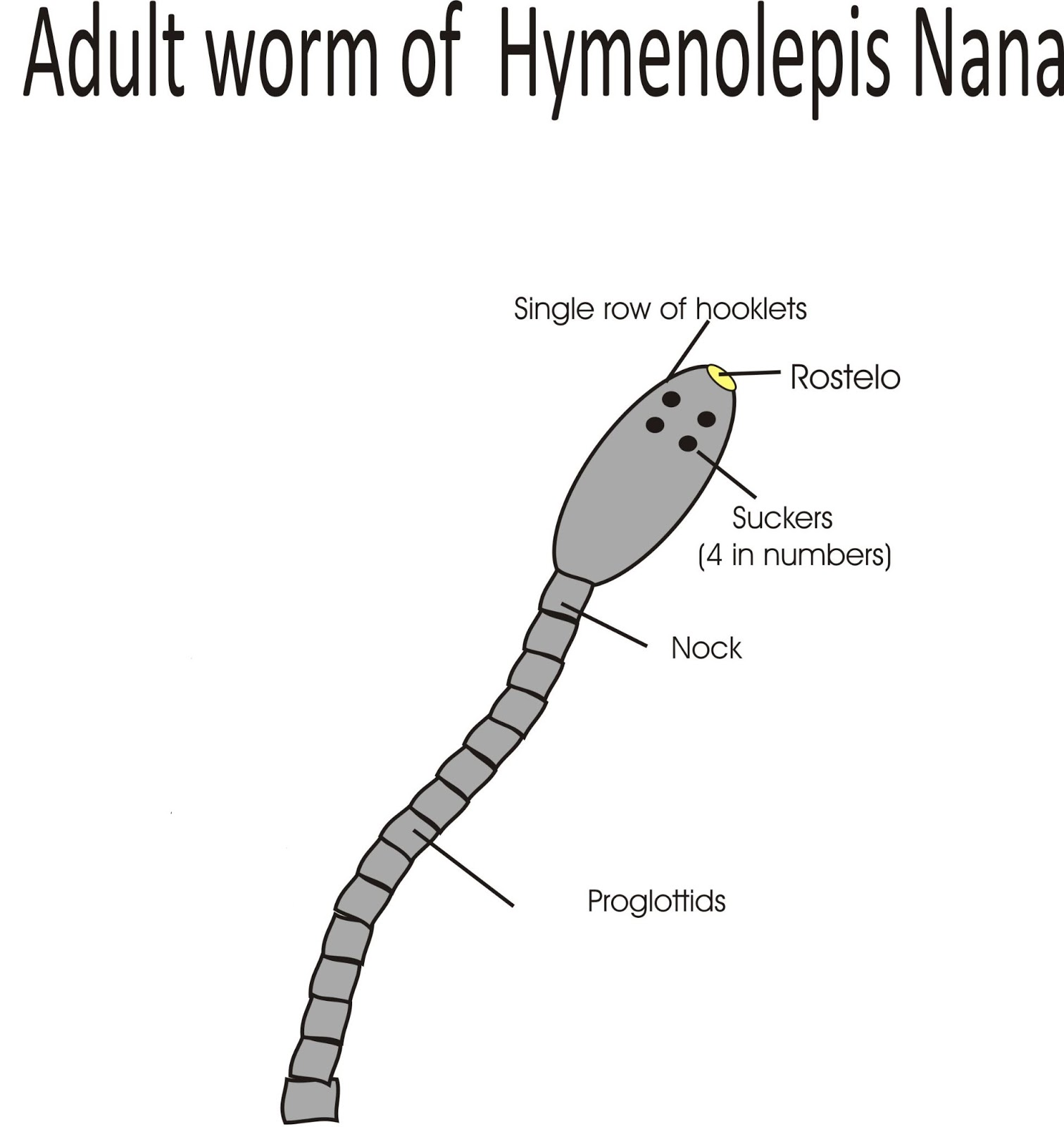
Hymenolepis nana is
(a) Dog tapeworm
(b) Dwarf tapeworm of man
(c) Pork tapeworm
(d) Dead man's finger
Answer
504.6k+ views
Hint: While most common in temperate zones, it is a cosmopolitan species and is one of the most common cestodes (a form of intestinal worm or helminth) that infect humans, particularly children. It is a small species, rarely exceeding 40 mm in length and 1 mm in width, as its name implies. The scolex bears a retractable rostellum, armed with 20 to 30 hooks in a single circle.
Complete answer:
The dwarf tapeworm is also called Hymenolepis nana. It is a tiny intestinal tapeworm that is the most common cestode in humans. The length of the nana is just 15 to 40 mm. To complete the life cycle, it only takes one host. Its larvae only migrate inside the gut wall and its lifespan (4 to 6 weeks) is relatively short. There are also four suckers in the Scolex or a tetrad. The neck is slender and long, and the segments are broader than the long ones. Genital pores are unilateral, and there are three testicles in each mature section. Gravid segments disintegrate after apolysis, releasing eggs that measure 30 to 47 μm in diameter. A thin, hyaline, outer membrane and an inner, dense membrane with polar thickenings that hold several filaments cover the oncosphere. This and the other families of tapeworms infecting humans lack the heavy embryophytes which give taeniid eggs their characteristic striated appearance. The rostellum in the apex of the organ remains invaginated. Hooklets from Rostellar are shaped like tuning forks. The spine, the region of growth, is long and slender. Strobila begins with small, narrow proglottids followed by mature proglottids.
Additional information:
Infection is most often acquired through ingestion from eggs in another infected person's feces, which are passed into food. In the duodenum, eggs hatch, releasing oncospheres, which penetrate the mucosa and lie in the villi's lymph channels. An oncosphere grows into a cysticercoid with a tail and a scolex that is well developed. With the rest of the worm still inside the cyst, it is made of longitudinal fibers and is spade-shaped. Cysticercoids grow into the lumen of the small intestine within five to six days, where they bind and mature.
So, the correct answer is ‘dwarf tapeworm of man’.
Note:
As with all other tapeworms, the dwarf tapeworm lacks a digestive system and feeds on nutrients in the intestinal lumen by absorption. They have non-specific criteria for carbohydrates and at that point, they appear to consume whatever is being passed through the intestine. When it becomes an adult, with its suckers and toothed rostellum, it attaches to the intestinal walls and has its segments stretching out into the intestinal space to consume food.

Complete answer:
The dwarf tapeworm is also called Hymenolepis nana. It is a tiny intestinal tapeworm that is the most common cestode in humans. The length of the nana is just 15 to 40 mm. To complete the life cycle, it only takes one host. Its larvae only migrate inside the gut wall and its lifespan (4 to 6 weeks) is relatively short. There are also four suckers in the Scolex or a tetrad. The neck is slender and long, and the segments are broader than the long ones. Genital pores are unilateral, and there are three testicles in each mature section. Gravid segments disintegrate after apolysis, releasing eggs that measure 30 to 47 μm in diameter. A thin, hyaline, outer membrane and an inner, dense membrane with polar thickenings that hold several filaments cover the oncosphere. This and the other families of tapeworms infecting humans lack the heavy embryophytes which give taeniid eggs their characteristic striated appearance. The rostellum in the apex of the organ remains invaginated. Hooklets from Rostellar are shaped like tuning forks. The spine, the region of growth, is long and slender. Strobila begins with small, narrow proglottids followed by mature proglottids.
Additional information:
Infection is most often acquired through ingestion from eggs in another infected person's feces, which are passed into food. In the duodenum, eggs hatch, releasing oncospheres, which penetrate the mucosa and lie in the villi's lymph channels. An oncosphere grows into a cysticercoid with a tail and a scolex that is well developed. With the rest of the worm still inside the cyst, it is made of longitudinal fibers and is spade-shaped. Cysticercoids grow into the lumen of the small intestine within five to six days, where they bind and mature.
So, the correct answer is ‘dwarf tapeworm of man’.
Note:
As with all other tapeworms, the dwarf tapeworm lacks a digestive system and feeds on nutrients in the intestinal lumen by absorption. They have non-specific criteria for carbohydrates and at that point, they appear to consume whatever is being passed through the intestine. When it becomes an adult, with its suckers and toothed rostellum, it attaches to the intestinal walls and has its segments stretching out into the intestinal space to consume food.

Recently Updated Pages
Master Class 12 Business Studies: Engaging Questions & Answers for Success

Master Class 12 Economics: Engaging Questions & Answers for Success

Master Class 12 English: Engaging Questions & Answers for Success

Master Class 12 Maths: Engaging Questions & Answers for Success

Master Class 12 Social Science: Engaging Questions & Answers for Success

Master Class 12 Chemistry: Engaging Questions & Answers for Success

Trending doubts
Which animal has three hearts class 11 biology CBSE

1 Quintal is equal to a 110 kg b 10 kg c 100kg d 1000 class 11 physics CBSE

Explain zero factorial class 11 maths CBSE

The camels hump is made of which tissues a Skeletal class 11 biology CBSE

How do I convert ms to kmh Give an example class 11 physics CBSE

The percentage of free SO3 in oleum sample which is class 11 chemistry CBSE




